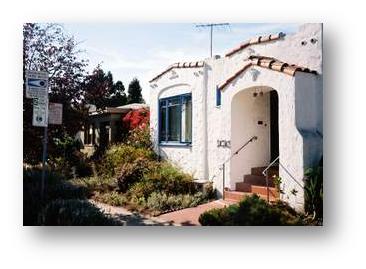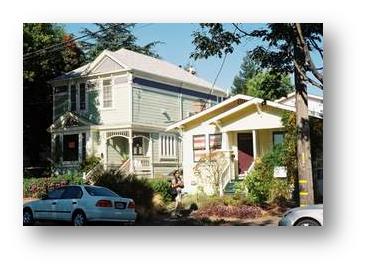
From 1900 to 1910 the population of Berkeley more than doubled. Much of this growth, particularly after the 1906 earthquake, took place in the McGee-Spaulding District, which until then had been semirural. Examples of pre-earthquake domestic architecture abound, however, and the District's two most notable public buildigs replaced others with the same functions on the same pre-earthquake sites. Of these the older, by one year,is the Catholic church of St. Joseph the Worker (1908), successor to a wooden gothic-style St. Joseph's (1883-86) that was demolished in 1913. The other is Old City Hall (now officially the Maudelle Shirek Building), built after fire destroyed the old Berkeley Town Hall on the site to which it had been moved in 1899. Both structures have long been city landmarks.
The earliest private residence that can be precisely dated is from 1884. Like several of its neighbors -- now, alas, listed under Buildings demolished -- it was the suburban mansion of a wealthy businessman who used Berkeley as his base for wider operations. There were also a few homeowners who still called themselves farmers, and at least one business manager, John Hunter, whose interests were local (see Landmarks and landmarking).
Other pre-1906 residents ranged from laborers and craftsmen to master mariners and builders. Despite a sprinkling of clerks, teachers and attorneys, however, the District was predominantly working class (see Demographics).
This mix of people produced a corresponding mix of buildings: Queen Anne and  Italianate Victorians for the prosperous; Classic Boxes and Rowhouses for the middle and secure working classes; and small cottages or shacks for the struggling or destitute. The shacks are long gone, demolished as the City upgraded its building codes, but the variety has persisted. It was enriched by the appearance, some time in the early 1900's, of the very first Craftsman Bungalows (see Architectural History).
Italianate Victorians for the prosperous; Classic Boxes and Rowhouses for the middle and secure working classes; and small cottages or shacks for the struggling or destitute. The shacks are long gone, demolished as the City upgraded its building codes, but the variety has persisted. It was enriched by the appearance, some time in the early 1900's, of the very first Craftsman Bungalows (see Architectural History).
The bungalow's runaway popularity after1906 can be traced to a combination of three main factors: adaptation of the Arts and Crafts ideal to middle-class budgets; mass marketing via precut lumber kits and cheap plans that offered choice but bypassed the need for an architect; and a comfortable fit between the bungalow's versatility and the servantless middle-class family's desire to combine gracious living with convenience (see Special Topics, in this section). Gracious living, in California, included year-round access to nature, which the McGee-Spaulding District supplied with its large but modestly priced building lots.
Starting in the early 1900's, the construction and subsequent enlargement of Berkeley High School led to many older houses being moved westward into the District, which still had land to spare. This movement in turn attracted older houses from other parts of Berkeley, so that the District became a kind of unofficial preservation park (see Buildings Moved Here). The 1920's building boom saw the spread of tile-roofed Mediterranean villas alongside the bungalows. Many older buildings were now remodeled for the automobile age, responsible for the demise of local rail lines in the 1930's. The District retained its popularity with commuters, however, and by the 1940's had been largely built out. Most of its houses are now over half a century old.
Postwar demand for housing inspired real-estate speculators to demolish many of the District's older homes in favor of "dingbat"apartment buildings (see Buildings demolished). This wholesale destruction of neighborhood character was eventually stopped by citizen protest (see Soap box: Zoning history). Today, thanks to much excellent rehab and remodeling, the District's neighborhoods have managed to grow in population without losing their small-scale intimacy. The variety of the McGee-Spaulding District as a repository of vernacular California architecture is beginning to attract serious study (see Walks). Despite its proximity to downtown Berkeley, the connection with nature and the semirural past has been maintained. It is a rich heritage, and one well worth preserving.